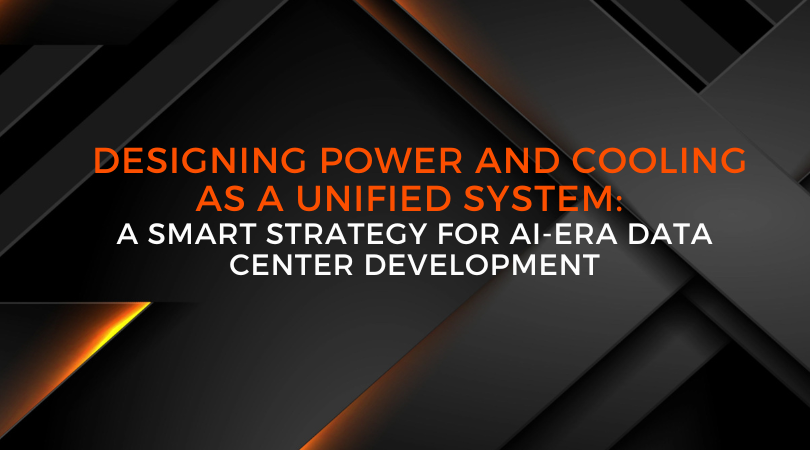Data centers are under more pressure than ever before. Workloads are denser, uptime expectations are non-negotiable, and the demand for efficiency both in performance and energy use, is relentless. AI workloads are changing the game, and traditional siloed approaches to infrastructure design no longer suffice.
One of the most pivotal design shifts taking place is the move from independently planning power and cooling systems to designing them as a single, integrated solution. This shift isn’t just a matter of operational preference, it’s quickly becoming a best practice for future-ready data center development.
Here’s why.
AI Workloads Demand Higher Densities and Greater Precision
AI training and inference engines require more power and generate significantly more heat than traditional IT workloads. Graphics Processing Units (GPUs) and AI accelerators are often deployed in rack densities exceeding 30kW and in some cases, even 50kW+.
Designing power and cooling separately in such high-density environments increases the risk of mismatched capacity and inefficiencies. A unified approach ensures that every watt of power consumed is accounted for in the cooling strategy, and that the cooling is precisely scaled to the actual thermal output of AI workloads.
Benefit: Tighter alignment between power consumption and thermal management reduces hotspots, increases system reliability, and allows for smarter scaling.
Reduces Energy Waste and Improves PUE
Power Usage Effectiveness (PUE) remains a key metric for evaluating data center efficiency. Traditionally, separate design processes for power and cooling can lead to overprovisioning building in buffer capacity “just in case” which results in unnecessary energy consumption and underutilized infrastructure.
By designing power and cooling as one cohesive system, engineers can right-size their infrastructure, eliminate redundancies, and take advantage of synergies like waste heat recovery or dynamic load balancing.
Benefit: Achieve lower PUE and operational costs while improving overall sustainability.
Simplifies Infrastructure Integration and Orchestration
The rise of intelligent infrastructure requires that the underlying systems speak the same language. When power and cooling are designed together, the integration of sensors, controls, and automation becomes seamless.
With unified design, facilities can dynamically adjust cooling output based on real-time power consumption and rack-level heat generation. This not only reduces wear-and-tear on mechanical systems but also extends the life of mission-critical infrastructure.
Benefit: Enable predictive management, reduce manual interventions, and future-proof for autonomous infrastructure.
Enhances Space Planning and Capacity Forecasting
Space is at a premium in modern data centers, especially colocation and edge environments. Disconnected power and cooling paths can lead to inefficient layouts, inaccessible infrastructure, and constraints on expansion.
Unified design enables a holistic view of physical space requirements, airflow paths, cable routing, and service clearances. It simplifies planning for “what’s next” by anticipating how future upgrades in AI hardware will impact both power and thermal needs.
Benefit: Optimize footprint, streamline deployment, and scale with agility.
Supports the Transition to Liquid Cooling
The move toward liquid cooling, whether rear-door heat exchangers, direct-to-chip, or immersion, is gaining momentum, especially for AI applications. These technologies drastically shift the power-to-cooling ratio and demand precise coordination between facility and IT design.
A unified approach ensures the electrical infrastructure supports new cooling modalities, including pumps, heat exchangers, and backup systems, and integrates easily with facility-wide thermal management strategies.
Benefit: Prepare for next-gen cooling without retrofitting or major overhauls.
Strengthens Risk Mitigation and Resiliency Planning
When power and cooling systems are planned independently, failure scenarios can become difficult to predict and manage. For example, a UPS failure or utility fluctuation could have cascading effects if the cooling system lacks corresponding backup or flexibility.
By designing both systems together, resiliency strategies such as redundancy (N+1, 2N), load shedding, and backup power distribution can be mirrored across the thermal environment.
Benefit: Increase uptime, reduce single points of failure, and build a stronger risk posture.
Delivers Better ROI and Business Value
Ultimately, data center development in the AI era isn’t just about technical excellence. It’s about business performance. Investors, customers, and end-users expect rapid deployment, low operational costs, and top-tier performance.
When power and cooling systems are developed as one, the benefits cascade throughout the organization: shorter project timelines, improved time to market, reduced TCO, and enhanced customer satisfaction.
Benefit: Align infrastructure performance with strategic business goals.
Think Holistic, Build Smarter
Designing power and cooling systems as a single, unified system is more than an engineering preference. It’s a strategic imperative in the AI era. As AI pushes data centers to new levels of density, complexity, and performance, a siloed mindset simply won’t keep pace.
Those who embrace a holistic, integrated design approach will gain a competitive edge, not only in efficiency and resiliency but in agility, sustainability, and future-readiness.
Interested in rethinking your data center strategy?
Let’s start a conversation about how to design smarter from the ground up.

